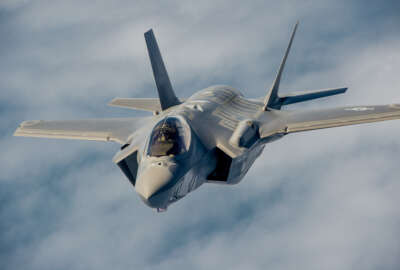The Air Force’s experimental, artificial intelligence-infused way of training pilots is almost ready to integrate some of its tricks into the full pilot curriculum.
After Pilot Training Next finishes its third cohort, probably sometime next summer, the Air Force will put some of the learning methods and data analytics into its full undergraduate pilot training (UPT), Lt. Gen. Brad Webb, leader of the Air Education and Training Command said Tuesday.
Pilot Training Next just finished up with its second cohort of pilots.
“We will cherry pick the things that are ripe from Pilot Training Next to incorporate into the UPT of the future,” Webb said at an Air Force Association event in National Harbor, MD. “The idea will be to scale all of those mature technologies.”
Webb added that some of the missionized aspects of the training may go into UPT depending on what the service’s assessment is next year.
“Some things are going to be wildly successful, some things we will need to go back to the drawing board” Webb said. “There are some data analytic technologies that can demonstrate how a human mind learns and what the natural peaks and valleys are over time for the ability of the brain to retain information. Data analytics can plot this and you can actually see areas where a person is weak or where they are task saturated and lose information.”
Webb said through this Air Force can cater the way it teaches pilots so they can learn better.
Pilot Training Next started more than two years ago in Austin, Texas. The program gives pilots their own flight simulators and takes their biometric measurements — like where their eyes focus and how fast their heart is beating. The Air Force is aggregating that data to find those peaks and valleys and to measure anxiety and other factors that affect flying.
The program also allows pilots to train whenever is best for them.
“It’s got seats like a normal arcade racing game, but instead of a steering wheel you have a stick to control the plane and instead of the gears you have the throttle and also on your feet you have the rudders. In front of you is a computer screen, it’s a normal Windows computer using virtual reality flight simulators that anyone can buy, and we also have virtual reality headsets that we put on our eyes,” 2nd Lt. Christopher Ahn, a Pilot Training Next graduate, told Federal News Network last year. “The great thing about this program is I can do it any time I want. Can’t sleep at night? I’m just going to hop in the simulator … We have it at home and we have it at work as well. The one at home I have in my living room.”
While the Air Force integrates those practices into its UPT, Webb said Pilot Training Next will continue to experiment.
The program worked with AFWERX — a team of innovators who connect industry and academia to the Air Force — last fall to integrate commercial-off-the-shelf technologies.
The program specifically called on industry to provide technologies that will help build a learning ecosystem that allows for real-time collaboration, cloud-based documents and an online knowledge repository. It also asked for debriefing tools, and smart gradesheets that are accessible from the internet so students can track their learning.
The program invested $500,000 in prototype and experimentation funding.
One of the technologies Pilot Training Next got out of the competition is the NeuroTracker, a 3D visual exercise that trains the brain and is used by professional athletes to better situational awareness.
Copyright
© 2024 Federal News Network. All rights reserved. This website is not intended for users located within the European Economic Area.
